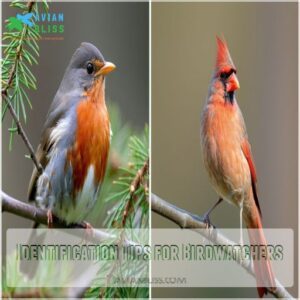This site is supported by our readers. We may earn a commission, at no cost to you, if you purchase through links.

Cardinals stand out with their bold crimson color and cheery tufted crests, like little feathered royalty. They’re slightly larger than robins, measuring about 21-23 cm compared to robins’ 12.5-14 cm.
Robins boast an orange-red breast and a knack for nabbing worms, while cardinals feast more on seeds.
Robins tend to be solo fliers, whereas cardinals stick with family, sharing songs and togetherness.
They both defend their turf fiercely, but in their own unique ways.
Curious about their neighborhood antics? Stay tuned for surprising tidbits!
Table Of Contents
- Key Takeaways
- Physical Characteristics of Red Robins and Cardinals
- Habitat Preferences and Geographic Distribution
- Behavioral Traits and Lifestyle Differences
- Nesting and Reproduction Strategies
- Vocalizations and Communication Methods
- Adaptations to Human-Altered Environments
- Cultural Significance and Symbolism
- Conservation Status and Environmental Impacts
- Identification Tips for Birdwatchers
- Interspecies Interactions and Ecological Roles
- Frequently Asked Questions (FAQs)
- Is there a difference between a Red Robin and a cardinal?
- Are Cardinals more brightly colored than Robins?
- Are Robins and Cardinals the same bird?
- Is a Redbird a cardinal?
- Are American robins bigger than northern cardinals?
- Are Robins more social than Cardinals?
- Are robins related to cardinals?
- Is a robin bigger than a cardinal?
- Is there a bird that resembles a robin?
- What is the difference between a cardinal and a red bird?
- Conclusion
Key Takeaways
- You’ll notice cardinals are larger and more vibrantly colored than robins, with their bright red feathers and distinctive crests, whereas robins flaunt an orange-red breast and a longer, slender shape.
- Cardinals are family-oriented, often seen in pairs or small groups, while robins are more independent, preferring to forage and travel solo outside the breeding season.
- Cardinals stick close to home, adapting well to urban areas with dense shrubbery, but robins migrate south in winter, thriving in open lawns and parks.
- In your backyard, cardinals stick to seed-packed feeders, whereas robins prefer gardens where they can hunt worms and insects, highlighting their different dietary needs.
Physical Characteristics of Red Robins and Cardinals
You’ll be amazed at how different these two red-feathered friends really are, from their distinctive body shapes to their unique color patterns.
Whether you’re watching cardinals show off their mohawk-like crests or admiring a robin’s orange-red breast, you’re about to discover what makes each of these backyard visitors special.
Size and Wingspan Comparison
Ever wondered about the size difference between these backyard favorites? Cardinals are the heavyweights, stretching 21-23 cm long with an impressive 25-31 cm wingspan. Red robins, meanwhile, keep things compact at 12.5-14 cm long with a 20-22 cm wingspan.
- Cardinals can look bulkier due to their fuller chest and crest
- Wing shape affects flight style – cardinals are agile, robins are swift
- Despite size differences, both species are excellent flyers
Plumage and Color Patterns
Looking at cardinals and robins side by side, you’ll notice their colors tell completely different stories.
Male cardinals steal the show with their brilliant crimson feathers from head to tail, while male robins sport a more modest orange-red breast with dark gray-brown backs.
Female cardinals rock a warm tan with reddish highlights, and female robins keep it subtle with lighter brown chest feathers.
Beak Shape and Function
When you spot a cardinal or robin at your feeder, their beaks tell different stories.
Cardinals pack powerful, cone-shaped beaks – perfect little nutcrackers that make quick work of tough seeds and nuts.
Robins, on the other hand, sport longer, more slender beaks built for plucking worms and insects.
These specialized tools shape not just how they eat, but where they hunt for food.
Eye Features and Markings
Moving past their beaks, let’s take a peek at the distinctive eye features that set these birds apart.
Both birds have sharp, binocular vision to spot tasty treats and potential predators, which is typical of birds with binocular vision, such as falcons with big eyes, allowing for accurate hunting and spotting prey from afar.
| Feature | Red Robin | Cardinal |
|---|---|---|
| Eye Color | Black | Black |
| Eye-Stripes | White | None |
| Pupil Shape | Round | Round |
| Vision Type | Binocular | Binocular |
| Night Vision | Limited | Limited |
Both birds have sharp, binocular vision to spot tasty treats and potential predators.
Sexual Dimorphism in Both Species
After studying bird eyes, you’ll be amazed by how differently male and female cardinals and robins dress for success.
Cardinals take the crown for most dramatic differences – male cardinals flash their brilliant red feathers like nature’s stop signs, while females keep it low-key with tan plumage.
Robins play it more subtle, with males showing slightly brighter orange breasts than their female counterparts.
Habitat Preferences and Geographic Distribution
Looking to spot cardinals and robins in your neighborhood? The secret’s in knowing where they call home. Cardinals thrive in thick, shrubby areas that offer plenty of cover, from dense woodland edges to your backyard bushes. You’ll find them mostly in the eastern and central United States, where they’re year-round residents.
Robins, on the other hand, prefer more open spaces. They’re famous for hopping across lawns and parks throughout North America, from Alaska to Mexico. While cardinals stick to warmer regions, robins aren’t afraid to brave the cold northern territories.
What’s interesting is how both birds have adapted to city life. Thanks to urban development, you’re just as likely to spot these feathered neighbors in a suburban garden as in their natural habitats.
Behavioral Traits and Lifestyle Differences
You’ll notice some fascinating differences in how cardinals and robins go about their daily lives, from the way they hunt for food to their unique social circles.
While cardinals prefer to stick close to home as permanent residents, robins are more adventurous travelers who’ll band together in flocks to find the best feeding spots.
Feeding Habits and Diet
Ever watched cardinals and robins sharing your backyard space?
Their dining preferences couldn’t be more different!
Here’s what’s on their menu:
| Food Type | Cardinal | Robin |
|---|---|---|
| Seeds | Loves | Meh |
| Fruits | Yum! | Yes |
| Insects | Sometimes | Main course |
| Worms | Rarely | Delicacy |
| Nectar | Sips | Nope |
Cardinals are passionate seed-eaters, while robins hunt juicy earthworms and insects.
Movement Patterns and Foraging Techniques
During your backyard birdwatching, you’ll notice striking differences in how cardinals and robins move while hunting for food.
Cardinals exhibit characteristics typical of their unique cardinal behavior patterns, such as those studied through resources on cardinal behavior, preferring a cautious approach, hopping deliberately from spot to spot as they search the ground.
Meanwhile, robins are more direct – they take quick, purposeful steps, frequently pausing to scan their surroundings, and often punctuate their landings with distinctive downward tail flicks.
Territorial Behaviors
After their peaceful foraging sessions, you’ll notice both robins and cardinals transform into fierce defenders of their space.
Here’s what sets their territorial behaviors apart:
| Behavior | Robin | Cardinal |
|---|---|---|
| Defense | Aggressive chasing | Vocal warnings |
| Song variation | Minimal | Complex repertoire |
| Nest defense | Dive-bombing intruders | Loud "chip" calls |
These distinctive strategies help each species protect their turf effectively.
Social Interactions and Family Groups
The social lives of cardinals and robins couldn’t be more different.
Some birds, like the bobolink, are known to travel in massive flocks with dominant males leading the way.
You’ll notice cardinals maintain strong family bonds, often staying together year-round as devoted couples.
They’ll even recruit extended family to help raise chicks!
Robins take a more independent approach, pairing up just for breeding season before going their separate ways.
Think of cardinals as the "family-first" birds, while robins prefer the solo life.
Migration Patterns
Standing among backyard birders, you’ll discover fascinating differences in how cardinals and robins handle the changing seasons.
Cardinals stick close to home year-round.
Robins, on the other hand, take a more flexible approach to migration.
Most robins head south when temperatures drop, though some tough it out in northern areas if they find enough food.
Notably, these migration choices directly impact their winter survival strategies.
Nesting and Reproduction Strategies
You’ll be amazed at how differently cardinals and robins approach their family planning, from their unique nest-building techniques to their distinctive parenting styles.
While both birds are dedicated parents, they’ve developed their own special strategies for raising their chicks.
You’re about to discover what makes each species’ approach so successful.
Nest Construction and Placement
Building a home takes serious skill, and these feathered architects don’t disappoint!
Cardinals and robins showcase distinct construction styles that’ll catch your eye.
Here’s what sets them apart:
| Feature | Robin | Cardinal |
|---|---|---|
| Materials | Grass, twigs | Leaves, bark |
| Location | Trees, ledges | Dense shrubs |
| Size | Cup-shaped, 6-8" | Loose, 2-3" |
Breeding Seasons and Timing
Love is in the air at different times for our feathered friends!
You’ll spot cardinals starting their family plans from February through September, while robins kick off their breeding season a bit later, from March to August.
Both species make the most of warm weather, typically raising 2-3 broods each season.
The timing’s perfect – when insects are plentiful and daylight’s long.
Egg Characteristics and Clutch Sizes
Ever noticed how different birds lay unique eggs?
Cardinal eggs are nature’s tiny masterpieces – each one a delicate blend of gray, green, or ivory speckled with brown dots. They typically lay 2-4 eggs per clutch.
Robin eggs catch everyone’s eye with their famous "robin’s egg blue" color, completely spotless, and they usually lay 3-5 eggs each time.
Incubation and Parental Care
Two distinct parenting styles set cardinals and robins apart in your backyard.
While mama cardinals take on incubation duties solo for 11-13 days, robin parents tag-team the task.
Here’s what makes their parental care unique:
- Cardinals feed their chicks a protein-rich diet of insects and seeds
- Robin parents share feeding duties every 15-20 minutes
- Female cardinals rarely leave the nest during incubation
- Both species remove eggshells after hatching
- Robin nestlings develop faster, leaving the nest in 14-16 days
Mating Behaviors and Pair Bonding
When a male cardinal spots his perfect match, you’re in for quite a show!
Unlike many birds, cardinals stick together for life, sharing elaborate courtship displays where the male feeds his chosen mate beak-to-beak.
Robins take a different approach – they’re seasonal romantics, pairing up each spring.
While their bonds may be temporary, they’re no less devoted during breeding season, vigorously defending their territory together.
Vocalizations and Communication Methods
You’ll be amazed at how differently cardinals and robins express themselves, from the cardinal’s clear "cheer-cheer-cheer" whistles to the robin’s cheerful "cheerily-cheer-up" songs.
Whether you’re trying to identify these feathered friends in your backyard or just curious about their communication styles, understanding their unique voices will help you tell them apart and appreciate their distinct personalities.
Song Patterns and Purposes
Have you noticed the melodious concert that fills your garden at dawn?
Cardinals and robins each bring their own unique songs to nature’s symphony.
Males of both species use complex tunes to establish territories and attract mates.
Cardinals whistle their clear "cheer-cheer-cheer," while robins deliver a string of warbled phrases.
Their songs change through seasons, creating a constantly changing backyard playlist.
Call Types and Meanings
Listen closely to a cardinal’s piercing "chip" or a robin’s sharp "peek" – these birds speak volumes through their calls.
While each has its signature song, they also use specific calls for different situations.
Like many birds, they learn these vocalizations through a process called songbird learning.
Cardinals belt out quick, metallic chips when danger’s near, while robins give a high-pitched "seee" alarm.
You’ll hear contact calls too – gentle notes that keep them together.
Female Singing Capabilities
You might be amazed to discover that female cardinals possess remarkable singing abilities, unlike their robin cousins.
While female robins do sing, they aren’t as accomplished vocalists as cardinals, and those interested in their melodies can explore products related to female robin songs online.
These talented ladies don’t just chirp – they perform complex melodies that serve multiple purposes in their daily lives.
They’ll sing to catch a mate’s attention, defend their turf, chat with their partners, and keep the flock’s social bonds strong.
Talk about breaking bird stereotypes!
Seasonal Variations in Vocalizations
Birdsong shifts dramatically as seasons change, creating an ever-changing backyard symphony.
While female cardinals share their musical talents year-round, seasonal patterns bring distinct variations in both species’ vocal activity:
- Spring mornings burst with territorial songs and mating calls
- Summer afternoons feature gentle contact calls between pairs and fledglings
- Winter months bring hushed tones, with occasional chips and whistles for foraging groups
Adaptations to Human-Altered Environments
You’ll be amazed at how these feathered neighbors have learned to thrive in your backyard, with both cardinals and robins adapting their natural behaviors to take advantage of urban life.
While both species have mastered suburban living,
you’re about to discover some fascinating differences in how they’ve adjusted to sharing space with humans,
from their feeding preferences to their clever nesting tricks.
Urban and Suburban Habitat Utilization
Through bustling streets and quiet suburbs, both cardinals and robins have mastered city living in fascinating ways.
Like many urban birds, they’ve adapted to city birds’ challenges by evolving unique strategies for foraging and nesting.
While cardinals prefer dense shrubs near buildings for nesting, robins boldly claim open spaces like lawns and parks.
You’ll spot cardinals ducking between hedges at dawn and dusk, while robins strut confidently across yards throughout the day, proving how differently these birds have adapted to human spaces.
Interactions With Bird Feeders and Gardens
Backyard gardens and feeders set the stage for fascinating differences between our feathered friends.
Cardinals show a distinct preference for sturdy platform feeders and tube feeders filled with black oil sunflower seeds.
Robins rarely visit traditional bird feeders at all.
Instead, they’ll patrol your garden beds, hunting for earthworms and insects, especially after a fresh rain has brought dinner closer to the surface.
Responses to Human Presence
Ever notice how differently cardinals and robins react when you step into your yard?
While cardinals play it safe, darting away at the slightest movement, robins show remarkable confidence around humans.
You’ll spot these red-breasted friends hopping boldly across your lawn, sometimes just feet away, particularly if they’re accustomed to visiting your bird feeder station.
Both species can learn to trust you over time, especially if you’re consistent with your feeding routine.
Nesting in Man-Made Structures
Nestled within our modern world, cardinals and robins have mastered the art of urban living.
While cardinals stick to their traditional preference for dense shrubs, they’ll occasionally surprise you by setting up home in your hanging planters.
Robins, on the other hand, are the true city slickers, confidently building nests on your porch lights, window ledges, and even air conditioning units.
Cultural Significance and Symbolism
You’ll find that both red robins and cardinals have left their mark on human culture, from serving as state birds to appearing in countless holiday cards and decorations.
While cardinals are often seen as spiritual messengers bringing comfort from deceased loved ones, robins have earned their reputation as the cheerful harbingers of spring, making both birds powerful symbols in different ways.
Representation in Art and Literature
From classic children’s books to modern art galleries, red robins and cardinals have left their mark on our cultural canvas.
You’ll spot these feathered friends adorning everything from holiday cards to famous paintings, each bringing their own unique symbolism.
While robins often represent spring’s arrival in literature, cardinals frequently appear as symbols of energy and warmth in contemporary artwork and poetry.
Spiritual and Religious Associations
Beyond their striking beauty, cardinals and robins hold deep spiritual significance across cultures.
In Native American beliefs, cardinals represent your loved ones visiting from the spirit world, while robins symbolize new beginnings and renewal.
When you spot a cardinal’s flash of red or hear a robin’s morning song, many believe it’s a divine message or blessing.
These birds often bring comfort during times of grief.
Use as Mascots and Emblems
Across the sports world and beyond, cardinals and robins have swooped into our cultural identity as powerful mascots and emblems.
These vibrant birds represent more than just team spirit – they’re symbols of strength and local pride:
| Organization | Cardinal | Robin |
|---|---|---|
| Sports Teams | St. Louis Cardinals (MLB) | Baltimore Orioles (MLB) |
| Universities | Stanford University | Tufts University |
| Corporate Logos | State Farm Insurance | Red Robin Restaurants |
Folklore and Superstitions
While sports teams proudly display cardinals and robins as mascots, the spiritual world holds even deeper meaning for these beloved birds.
Cardinals often appear as spiritual messengers, with many people believing they’re visits from departed loved ones.
Robins carry their own mystical significance – they’re seen as harbingers of spring and new beginnings.
These beliefs turn everyday bird watching into meaningful moments of connection.
Conservation Status and Environmental Impacts
You’ll want to know how these beloved backyard birds are doing in today’s changing world, as both species face different environmental challenges.
While robins seem to be everywhere with their estimated population of 300 million across America, cardinals are dealing with unique pressures that might surprise you.
Population Trends and Threats
Your feathered friends face real threats: shrinking nesting spots, less food due to pesticide exposure, and "cute" cats.
Warmer winters upset their migration and breeding schedules, reshaping their world as climate change and urbanization impact habitats.
Despite these challenges, they endure, adapting and thriving, but they need a little help to stay our beloved backyard buddies.
Habitat Loss and Fragmentation Effects
Habitat loss hits robins and cardinals hard.
Shrinking habitats, thanks to urban sprawl and deforestation, fragment their homes.
This isolation impacts their ability to find mates, impacting breeding success and genetic diversity.
It’s like being stuck in a tiny apartment – not ideal for raising a family!
Three key consequences are: reduced food, increased disease spread, and lower population numbers.
Climate Change Implications
Climate change is shaking up the routines of robins and cardinals.
They’re adjusting their range shifts and migration patterns, trying to find food amidst habitat loss.
Picture trying to stick to your breeding cycles when the weather’s all mixed up.
It’s no wonder these bird species face challenges, like population declines and lifespan impacts, as the world changes around them.
Conservation Efforts and Protections
Imagine your backyard buzzing with life as you join the bird-saving brigade!
Get involved in bird conservation by creating cozy backyard habitats, championing wildlife groups, and pushing for stronger legal protections.
These steps battle invasive species, revitalize homes, and sometimes involve captive breeding programs.
Your small actions can help cardinals and robins flourish in their natural surrounds!
Identification Tips for Birdwatchers
If you’ve ever mixed up a cardinal with a red robin, you’re not alone, but don’t worry—there are easy ways to tell them apart.
With tips on key visual markers and behavioral cues, you’ll be spotting these birds like a pro in no time, even if they change their coats for the season.
Key Visual Markers for Each Species
Spotting a red robin and a cardinal is like day and night.
Robins have soft gray-brown backs with those unmistakable orange bellies, plus slender yellow beaks.
Don’t miss the robin’s white eye rings, another handy clue.
Cardinals, on the other hand, steal the show with fiery red plumage, a striking crest, and thick orange beaks.
Behavioral Cues for Recognition
Get to know your feathered buddies through their unique antics.
Cardinals and robins have distinct flight patterns: cardinals zig-zag, while robins glide.
Notice how cardinals crack seeds and robins hunt worms.
When alert, cardinals chirp loudly, robins freeze.
Watch cardinals sway in courtship and robins strut confidently.
Observing these traits makes birdwatching an exciting adventure!
Seasonal Appearance Changes
Ever wonder how birds change their look? Cardinals keep their red, but might seem a bit duller in winter. Robins? They’re quite the chameleons! Their bright orange chests can fade to a muted color in the fall. It’s all part of their seasonal molting, a natural process. This process is vital for their feather health and is often triggered by factors like temperature and day length, which are key molting triggers.
These color variations help them blend in with their surroundings.
Want to know more? Here’s what you need to know:
- Seasonal molting is a natural process
- Winter plumage is different than breeding plumage
- Color variation helps with camouflage
- Feather changes often depend on the season
- Bird identification can be tricky due to seasonal appearance changes
Common Misidentifications and Look-alikes
Imagine this: you’re glancing at the branches, and you spot something red. It’s not a red-winged blackbird or scarlet tanager, but is it a cardinal or a red robin?
Cardinals flaunt crested heads and chunky beaks, while robins boast sleek forms.
Juveniles and color variations might confuse, but watch their behaviors and know your region to distinguish.
Interspecies Interactions and Ecological Roles
When you compare red robins and cardinals, you’ll discover they each play unique roles in their ecosystems, from seed spreading to being part of the food chain.
It’s fascinating how these colorful birds interact with their environment, contributing to the local biodiversity in ways that might make you see your backyard in a whole new light!
Predator-Prey Relationships
Imagine robins and cardinals, those delightful garden visitors, facing the complex world of predator-prey dynamics.
From hawks’ sharp eyes to predatory cats’ stealthy prowls, they’re always on high alert.
These birds use clever camouflage and sharp instincts to dodge danger, showing us a fascinating side of wildlife.
It’s a delicate dance, keeping both bird and ecosystem thriving harmoniously.
Seed Dispersal and Pollination Contributions
You mightn’t think robins and cardinals are essential for forests, yet these birds are highly important for seed dispersal and pollination.
As nature’s gardeners, they spread seeds, enhancing plant diversity and forest regeneration.
Their seed dispersal mechanisms benefit ecosystem health by fostering plant community dynamics and offering mutualism benefits, even interacting with invasive species subtly influencing habitats and diets.
Impacts on Local Ecosystems
You’re wandering through your garden and witness red robins and cardinals working their magic on the ecosystem. Here’s how:
- Insect Control: These birds devour pests like they’re at a buffet.
- Seed Dispersal: They’re nature’s gardeners, scattering seeds for tomorrow’s forests.
- Food Web Dynamics: By controlling insect populations, they smooth food chains across the habitat.
Embrace these backyard birds for wildlife conservation and ecological balance.
Frequently Asked Questions (FAQs)
Is there a difference between a Red Robin and a cardinal?
Red robin" usually refers to the American robin, which is gray with a red-orange breast.
Unlike the Northern cardinal, which is entirely red, especially in males.
They’re distinct birds, often misidentified due to color associations.
Are Cardinals more brightly colored than Robins?
Cardinals often outshine robins with their vivid red feathers, especially the males.
While robins boast orange-red chests, it’s the cardinal’s all-over bright red plumage that makes them stand out as more vibrant and eye-catching.
Are Robins and Cardinals the same bird?
Imagine spotting a flash of vibrant red feathers.
Robins and Cardinals aren’t the same bird.
Cardinals boast solid red plumage, while robins have a red-orange breast.
Their differences include size, song, and behavior, making each unique.
Is a Redbird a cardinal?
Wondering if "redbird" refers to a cardinal?
You’ve nailed it!
In many areas, people use "redbird" to talk about the Northern Cardinal.
With their vibrant red feathers, cardinals really earn their colorful nickname.
Are American robins bigger than northern cardinals?
Like comparing peas in a pod, American robins are indeed larger than northern cardinals.
Robins boast a heftier body and longer tail, making them more noticeable in your yard compared to the daintier cardinal.
Are Robins more social than Cardinals?
Robins, often seen flitting about in large, friendly flocks, are typically more social than the more solitary Cardinals.
While Cardinals might hang out in pairs or small groups, Robins embrace a bustling communal life.
Are robins related to cardinals?
Cardinals and robins aren’t closely related; they belong to different families.
Cardinals are in the Cardinalidae family, while robins are in the Turdidae family.
Think of them as distant cousins, not siblings!
Is a robin bigger than a cardinal?
With around 300 million American robins fluttering through North America’s skies, these birds indeed outsize Northern cardinals.
Robins are larger and often more rotund, which makes spotting them in your backyard an easy task.
Is there a bird that resembles a robin?
You might find the Eastern Towhee resembles a robin, with its striking black, white, and rusty red coloring.
It’s like spotting your neighbor’s cousin—familiar yet different.
Their presence is a delightful surprise in gardens.
What is the difference between a cardinal and a red bird?
A cardinal, with its vibrant red feathers and iconic crest, is a specific bird species.
"Red bird" is a general term that can include any red-colored bird, like the cardinal, without specifying the species.
Conclusion
When you explore the feathered world of the red robin vs cardinal, it’s like comparing apples to oranges, each with its own charm.
Cardinals dazzle with their crimson coats and social flocks, while solitary robins quietly flaunt their worm-catching skills and orange breasts.
Understanding their habits, like where robins roam solo and cardinals serenade in pairs, enriches every birdwatching adventure.
These colorful contrasts make birdwatching both a challenge and a joy for nature lovers.
















